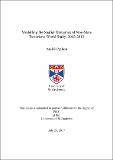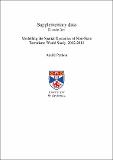Files in this item
Modelling the spatial dynamics of non-state terrorism : world study, 2002-2013
Item metadata
| dc.contributor.advisor | Illian, Janine | |
| dc.contributor.advisor | Argomaniz, Javier | |
| dc.contributor.author | Python, André | |
| dc.coverage.spatial | 208 | en_US |
| dc.date.accessioned | 2017-11-13T11:46:23Z | |
| dc.date.available | 2017-11-13T11:46:23Z | |
| dc.date.issued | 2017-12-07 | |
| dc.identifier.uri | https://hdl.handle.net/10023/12067 | |
| dc.description.abstract | To this day, terrorism perpetrated by non-state actors persists as a worldwide threat, as exemplified by the recent lethal attacks in Paris, London, Brussels, and the ongoing massacres perpetrated by the Islamic State in Iraq, Syria and neighbouring countries. In response, states deploy various counterterrorism policies, the costs of which could be reduced through more efficient preventive measures. The literature has not applied statistical models able to account for complex spatio-temporal dependencies, despite their potential for explaining and preventing non-state terrorism at the sub-national level. In an effort to address this shortcoming, this thesis employs Bayesian hierarchical models, where the spatial random field is represented by a stochastic partial differential equation. The results show that lethal terrorist attacks perpetrated by non-state actors tend to be concentrated in areas located within failed states from which they may diffuse locally, towards neighbouring areas. At the sub-national level, the propensity of attacks to be lethal and the frequency of lethal attacks appear to be driven by antagonistic mechanisms. Attacks are more likely to be lethal far away from large cities, at higher altitudes, in less economically developed areas, and in locations with higher ethnic diversity. In contrast, the frequency of lethal attacks tends to be higher in more economically developed areas, close to large cities, and within democratic countries. | en_US |
| dc.language.iso | en | en_US |
| dc.publisher | University of St Andrews | en |
| dc.rights | Attribution-NonCommercial-NoDerivatives 4.0 International | * |
| dc.rights.uri | http://creativecommons.org/licenses/by-nc-nd/4.0/ | * |
| dc.subject | Terrorism | en_US |
| dc.subject | SPDE | en_US |
| dc.subject | GMRF | en_US |
| dc.subject | Bayesian | en_US |
| dc.subject | Space-time | en_US |
| dc.subject | Spatial modelling | en_US |
| dc.subject.lcc | HV6431.P88 | |
| dc.subject.lcsh | Terrorism--Mathematical models. | en |
| dc.subject.lcsh | Bayesian statistical decision theory. | en |
| dc.title | Modelling the spatial dynamics of non-state terrorism : world study, 2002-2013 | en_US |
| dc.type | Thesis | en_US |
| dc.contributor.sponsor | University of St Andrews. Centre for Research into Ecological and Environmental Modelling (CREEM) | en_US |
| dc.type.qualificationlevel | Doctoral | en_US |
| dc.type.qualificationname | PhD Doctor of Philosophy | en_US |
| dc.publisher.institution | The University of St Andrews | en_US |
The following licence files are associated with this item:
This item appears in the following Collection(s)
Except where otherwise noted within the work, this item's licence for re-use is described as Attribution-NonCommercial-NoDerivatives 4.0 International
Items in the St Andrews Research Repository are protected by copyright, with all rights reserved, unless otherwise indicated.



